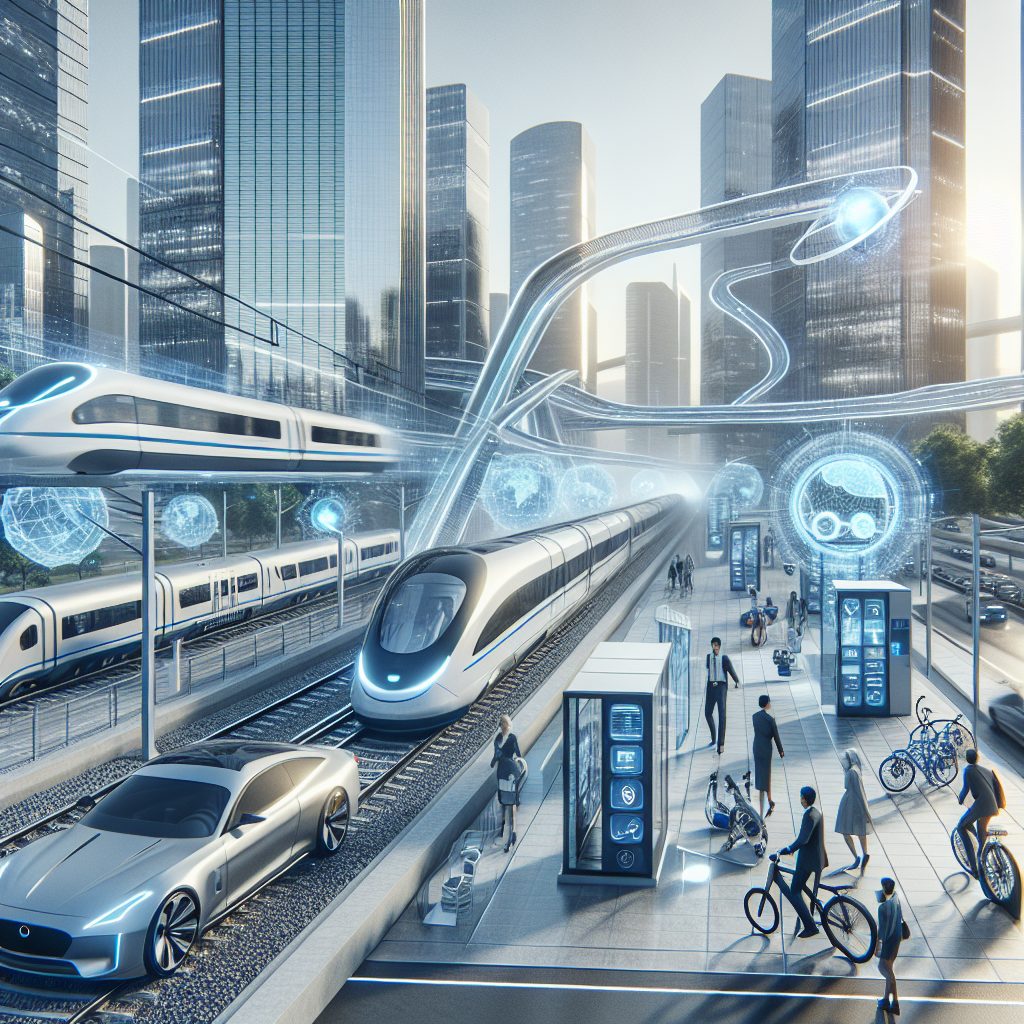As the world hurtles towards a future where movement is key, investing in mobility and transportation has never been more crucial. We stand on the cusp of transformation, with innovative technologies reshaping how we navigate our lives. From electric vehicles to smart infrastructure, this article peels back the layers of tomorrow’s travel tapestry. You’re about to dive into an exploration of cutting-edge advancements and investment trends that promise to redefine our journeys.
Curiosity piqued? Hang tight! You’ll uncover insights on sustainable transport solutions and the economic engines powering them forward. Learn how your choices today could influence the global mobility landscape. We’re talking clean energy, urban planning, and the Internet of Things (IoT) – all working in concert to smooth out the kinks in our commutes. So buckle up; let’s take a ride into the fascinating world of modern movement where every turn brings a new possibility for innovation and efficiency.
Important Highlights
1. Electric Vehicle Expansion: The surge in electric vehicle (EV) adoption is a transformative trend within the mobility sector, driven by technological advancements and environmental concerns. Governments worldwide are incentivizing EV use through subsidies, reflecting a commitment to reduce carbon emissions. Automakers are responding to this shift by diversifying their portfolios, indicating a significant move away from traditional combustion engines towards more sustainable transportation options.
2. Autonomous Technology Investment: Companies are heavily investing in autonomous driving technology, seeking to revolutionize how we commute. Self-driving vehicles promise greater efficiency and safety on the roads, with tech giants and automotive industry leaders racing to develop the first widely accepted autonomous platform. This technology not only has the potential to disrupt personal transport but could also transform public transportation and logistics.
3. Public Transport Modernization: Cities globally are modernizing public transportation systems to meet growing urbanization challenges. Investments in high-speed rail networks, bus rapid transit (BRT) lanes, and smart ticketing solutions aim to enhance efficiency and rider experience. Such upgrades are crucial for managing dense populations and reducing traffic congestion, as well as contributing to lower greenhouse gas emissions.
4. Micro-mobility Emergence: Micro-mobility solutions like e-scooters and bike-sharing programs have emerged as popular alternatives for short-distance travel. These options provide flexible and affordable movement within urban environments, addressing last-mile connectivity issues that often plague city dwellers. As micro-mobility platforms continue to proliferate, they present an opportunity for investors looking at niche markets within the broader transportation ecosystem.
5. Integrated Mobility Platforms: The rise of integrated mobility platforms is streamlining transportation by combining various modes of travel into single-access applications. These digital interfaces allow users to plan routes, book rides, and pay for services across multiple transport options, including taxis, bikes, public transit, and ride-hailing services—encouraging a shift away from private car ownership towards a shared economy model that prioritizes convenience and sustainability over personal vehicle usage.
Emerging Trends in Mobility and Transportation
The landscape of mobility and transportation is undergoing a seismic shift, with innovative technologies paving the way for more efficient, sustainable, and accessible modes of movement. Electric vehicles (EVs) continue to dominate the conversation, as major manufacturers ramp up production to meet growing consumer demand and environmental regulations. Autonomous driving technology also plays a pivotal role, with companies like Tesla and Waymo leading the charge in self-driving advancements.
Funding Infrastructure for Future Transport Systems
Investing in the infrastructure required to support the next generation of transportation is vital. This includes expanding EV charging networks, updating roadways for autonomous vehicle compatibility, and improving public transport systems. Governments worldwide are allocating significant resources, such as through initiatives like the Build America Bureau, which facilitates investment in infrastructure projects across the United States.
Smart Cities and Integrated Mobility Solutions
As urban areas become more congested, smart city concepts offer integrated mobility solutions that prioritize efficiency and reduce environmental impact. These solutions often include real-time traffic management systems, multimodal transport options linking personal vehicles, rideshares, bicycles, and pedestrian pathways, as well as data analytics platforms that optimize route planning and reduce commute times.
Innovative Public Transit Developments
Public transit systems are being reimagined to cater to modern-day commuters. High-speed rail networks promise to slash travel times between cities. Meanwhile, urban transit is seeing an influx of light rail and bus rapid transit lines designed to provide high-capacity service with reduced overhead costs compared to traditional metro systems.
Economic Impacts of Investment in Transportation
The economic benefits of investing in transportation are manifold. Job creation spans from construction roles for infrastructure projects to high-tech positions within the autonomous driving sector. Additionally, improved mobility can lead to increased commerce as goods and services move more freely across regions.
Sustainable Practices in Transit Development
Sustainability remains at the core of future transport development strategies. Efforts include transitioning public bus fleets to electric or hybrid models, designing walkable neighborhoods that decrease reliance on personal vehicles, and implementing policies that encourage carpooling and decreased single-occupant vehicle use.
The Role of Policy in Shaping Transportation’s Future
Governments play a crucial role by enacting policies that incentivize green transportation options. Tax credits for EV purchases, grants for renewable energy infrastructure, and urban planning guidelines all influence how both consumers and industry stakeholders approach mobility.
Advancements in Alternative Fuels
Beyond electricity, research into hydrogen fuel cells and biofuels continues to offer promising alternatives to fossil fuels. These technologies not only power vehicles but also have potential applications in larger scale transport such as shipping and aviation.
Tech Integration: AI & IoT in Transportation
Artificial Intelligence (AI) and the Internet of Things (IoT) are revolutionizing how we navigate our world. From predictive maintenance on public buses reducing downtime to smart traffic lights minimizing congestion, these technologies create a more responsive and adaptive transportation network.
The Future of Personal Mobility Devices
Last-mile solutions like e-scooters and e-bikes have transformed personal mobility options within cities. As these devices become smarter and more connected through apps and IoT integration, their popularity will likely surge alongside investments in safe docking stations and dedicated lanes.
Data Security & Privacy Concerns in Modern Transportation
With increased connectivity comes heightened concerns surrounding data security and privacy. Ensuring robust cybersecurity measures protect users’ personal information from potential threats is essential for maintaining public trust in new transportation technologies.
Rethinking Ownership: The Rise of Mobility as a Service (MaaS)
Mobility as a Service (MaaS) challenges traditional vehicle ownership models by offering subscription-based access to various transport modes. This trend encourages people to choose the most appropriate form of transport for each trip rather than defaulting to private car use.
- How can individuals invest wisely in emerging mobility options?
- What strategies ensure sustainable development within transportation sectors?
- In what ways can local governments support innovation in public transit?
- Which safety protocols are necessary when integrating AI into transport systems?
- How will MaaS redefine personal transportation habits?
Frequently Asked Questions
What are the key trends shaping the future of transportation?
The future of transport is being molded by electrification, autonomous technology, smart infrastructure, and shared mobility services. These innovations aim to create more efficient, sustainable, and convenient travel options.
How is investing in mobility beneficial for cities?
Investing in advanced mobility solutions can reduce congestion, improve air quality, and provide equitable access to transportation. It’s a step towards healthier and more liveable urban spaces.
Will self-driving cars become mainstream soon?
While self-driving technology is advancing rapidly, widespread adoption may take time due to regulatory, technological, and public acceptance factors. However, pilot programs are increasingly common, indicating significant progress.
What role do electric vehicles play in modern transportation?
Electric vehicles (EVs) are crucial for reducing emissions and dependence on fossil fuels. They’re becoming more popular as battery technology improves and charging infrastructure expands.
Can public transport systems keep up with growing urban populations?
Yes, but it requires investment in scalable solutions like rapid transit lines and digital ticketing systems to enhance capacity and user experience.
How important is connectivity in future mobility systems?
Hugely important. Integrated networks allow different modes of transport to communicate, creating a seamless travel experience and improving traffic management.
Is personal car ownership likely to decline?
With the rise of ride-sharing and as-a-service models, many people may opt for these flexible options over owning a vehicle, especially in densely populated areas.
What challenges exist in transitioning to greener transportation?
Main challenges include funding the required infrastructure, ensuring technology accessibility across communities, and aligning policy with rapid tech advancements.
How Do Investments in Smart Cities Impact Mobility and Transportation Solutions?
Investments in smart cities are transforming mobility and transportation solutions, enhancing efficiency and accessibility. By integrating advanced technologies and sustainable practices, these initiatives are not only improving daily commutes but also reducing congestion and emissions. Ultimately, they play a crucial role in shaping urban landscapes for tomorrow’s needs.
How can individuals contribute to sustainable mobility?
People can use public transit more often, participate in carpooling or bike-sharing programs, and support policies that encourage green transportation initiatives.
Are there economic benefits to investing in modern transportation technologies?
Absolutely. Such investments can boost job creation in new industries, stimulate economic growth through improved logistics efficiency, and save costs related to health issues from pollution.
Closing Thoughts on the Journey Ahead
Mobility and transportation stand at a pivotal crossroads. The decisions we make now will shape our environmental footprint and urban lifestyles for decades. Investing wisely in innovative transport solutions not only promises a cleaner planet but also heralds an era of unprecedented convenience and connectivity. Let’s embrace this journey with optimism and action.
The road ahead is exciting—full of potential for discovery and improvement. By prioritizing sustainability in our movements today, we pave the way for a brighter tomorrow where technology serves humanity’s best interests. Our collective efforts in shaping the future of movement will determine the legacy we leave for generations to come.

